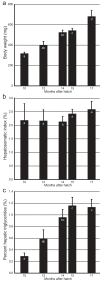Reassessment of the function of somatolactin alpha in lipid metabolism using medaka mutant and transgenic strains
- PMID: 22827540
- PMCID: PMC3467165
- DOI: 10.1186/1471-2156-13-64
Reassessment of the function of somatolactin alpha in lipid metabolism using medaka mutant and transgenic strains
Abstract
Background: Somatolactin alpha (SLa) is a fish-specific peptide hormone secreted from the pituitary. In medaka, SLa functions to darken the skin color and lack of SLa makes it pale. Transcription of SLa is enhanced or suppressed when fish are kept in dark or bright conditions, respectively, indicating SLa's important role in background acclimation of the skin color. Bizarrely, however, the lack of SLa seems to cause the additional defect of increased triglycerides in organs, which could not be rescued (decreased) by its overexpression.
Results: To assess this enigmatic result, we investigated genetic (the SLa, Slc45a2, r, and Y genes) and nongenetic (age, fasting, water temperature, and background color) effects on hepatic triglycerides. These experiments found that percent hepatic triglycerides quickly change in response to external/internal environments. Effects of SLa seemed to be much less obvious, although it may increase the proportion of hepatic triglycerides at least during certain breeding conditions or under certain genetic backgrounds.
Conclusions: The present results do not exclude the possibility that SLa takes part in lipid metabolism or other physiological processes. However, we suggest that skin-color regulation is the only definite role of SLa so far demonstrated in this species.
Figures



References
-
- Fukamachi S, Yada T, Meyer A, Kinoshita M. Effects of constitutive expression of somatolactin alpha on skin pigmentation in medaka. Gene. 2009;442(1–2):81–87. - PubMed
-
- Fukamachi S. In: Medaka: Model for organogenesis, human disease and evolution. Tanaka M, Naruse K, Takeda H, editor. Springer, Japan; 2011. Medaka spontaneous mutants for body coloration; pp. 173–184.
Publication types
MeSH terms
Substances
LinkOut - more resources
Full Text Sources

